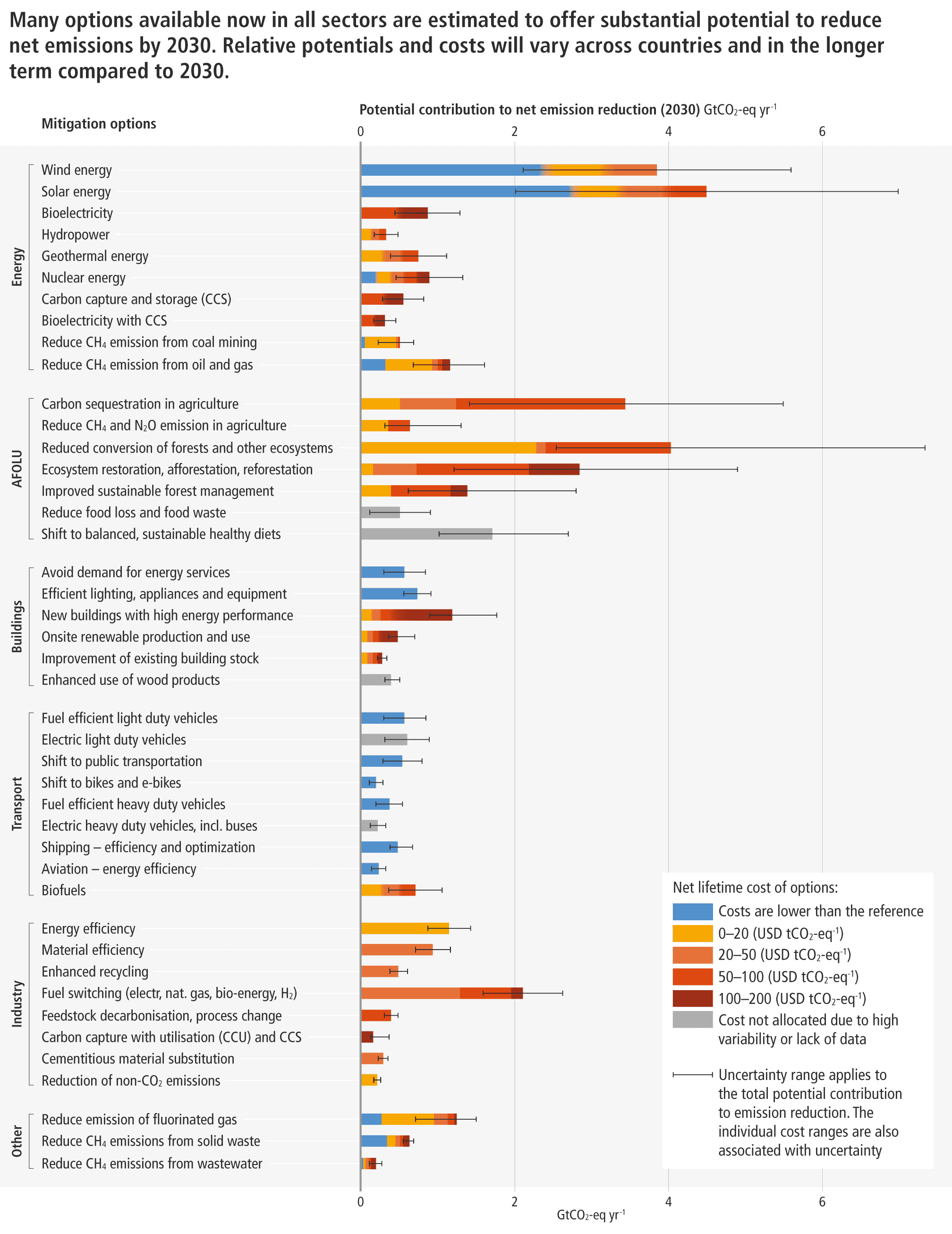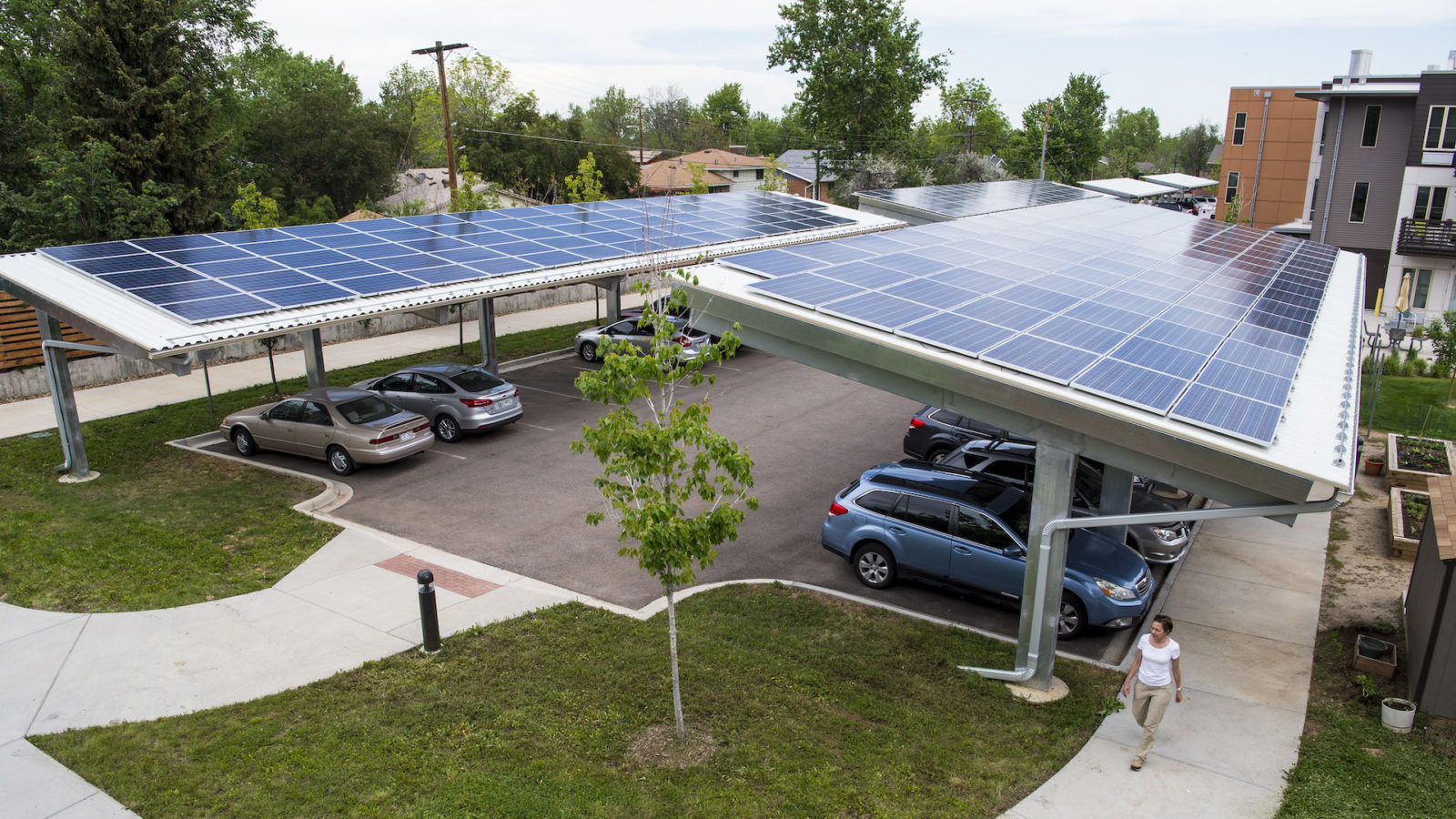Key Takeaways
The latest research from the Intergovernmental Panel of Climate Change (IPCC) points to a dire conclusion: if we’re to avoid the worst impacts of climate change, the time to act is now. In the new Working Group III (WG3) contribution to the climate change body’s Sixth Assessment Report, the authors were tasked with assessing global emissions reduction efforts that are necessary to limit global warming to 2℃, or ideally, 1.5℃. WG3’s contribution analyzes models that predict future emissions levels, scientific studies, and mitigation strategies that have already been implemented.
The report looks at global solutions to this crisis, but individual nations are responsible for making pledges and keeping their promises. Since the United States Federal government has been unable to pass meaningful climate policy, individual states are still at the forefront of the country’s collective progress on reducing emissions. Though the overriding call to action in this report is often repeated, there are several key takeaways that lawmakers and advocates can act on at the state level.
Greenhouse gas emissions are still increasing, and they must stop soon
The IPCC report found that we will likely exceed 1.5℃ of warming even if all of the countries that have pledged to reduce emissions actually meet those goals. There is already a gap in the implementation of promised climate action; policies in place by the end of 2020 fall short of what U.N. member nations promised. Additionally, the IPCC found that in scenarios that limit warming to 1.5℃, there’s another gap in 2030 between where the Nationally Determined Contribution pledges get us, and where emissions need to be.
Since 2010, global GHG emissions have increased across all major sectors. Although energy produced from fossil fuels has become more efficient, those improvements are overshadowed by increased overall activity. The report found that global carbon intensity, a measurement of the efficiency of energy produced from carbon, was decreasing, but not enough to achieve global temperature goals.
Additionally, in all of the models that limit warming to 1.5℃, our global GHG emissions peak by 2025. Even then, the report notes that rapid, deep, and immediate emissions reduction must follow throughout the next 30 years. The IPCC projects that based on policies currently in place, we’re going to miss this mark. The goal is to limit warming to 1.5℃; we’re currently projected to see 3.2℃ this century.
State Policy Examples: Creating Emissions Reduction Targets
Maryland
In April 2022, Maryland passed the Climate Solutions Now Act which requires the state to reduce GHG emissions by 60 percent below 2006 levels by 2031 and targets net-zero emissions by 2045. This legislation has one of the strongest emissions reduction requirements for any state in the country, includes pathways for decarbonizing buildings and transportation, and has provisions to invest in climate justice.
Massachusetts
Massachusetts’ Next Generation Roadmap Act (2021) codified the state’s preexisting goal of reaching net-zero by 2050 into law and set up interim targets each preceding five years. The Commonwealth’s law also requires the state to set goals in six economic sectors that only become legally binding if the state fails to meet one of its overall five-year targets. The legislation also attempts to increase transparency by requiring the governor’s office hold a public planning process for how the state will achieve each five-year limit and sector-specific goal.
Resources
- National Conference of State Legislatures — GHG Target Tracker
- Climate XChange — How Do States Plan to Meet their Climate Commitments?
- Clean Energy States Alliance — Advice for States on 100% Clean Energy Planning
Low-emissions technology is getting more affordable
As low-emissions technology options improve and their cost declines, the IPCC finds they now present a viable alternative to fossil fuels. From 2010–2019, the global cost of clean technologies decreased 85 percent for solar power, 55 percent for wind power, and 85 percent for advanced batteries essential for energy storage. Additionally, deployment of solar technology has increased tenfold and electric vehicles are 100 times more prevalent.
The IPCC report found that several policy instruments can both reduce the cost of green technologies and stimulate their adoption. Publicly funding research and development for these technologies can lower production costs and improve their overall energy potential. When governments fund demonstration and pilot projects, like this one in Massachusetts, public support often increases because their benefits become more apparent.
Low-emissions technologies can cut emissions, and can do so at a lower cost. The IPCC estimates that by 2030, mitigation strategies costing $100 or less per ton of carbon dioxide (CO2) saved each year could reduce emissions by half of the 2019 levels. A large portion of the reductions come from strategies that cost less than $20 per ton of CO2. These include generating solar and wind energy, improving energy efficiency measures, protecting ecosystems, and reducing the emissions of other powerful GHGs, like methane.

State Policy Examples: Supporting Low-Emissions Technology
Washington
Washington’s SB 5116 (2019) requires the state’s utilities to provide 100 percent carbon neutral power by 2030 and become carbon free by 2045. It’s important to note that though a majority of this power will come from inexpensive wind and solar, up to 20 percent of the target can be met through renewable energy credits, funding energy transformation projects, and paying a $100/ton CO2 penalty. Still, the state’s Renewable Portfolio Standard is one of the most aggressive in the country.
New York
New York State’s Climate Action Council is attempting to explain the economic benefits of their latest plan to the public. They’ve just begun a comment period for the state’s Climate Action Plan to meet strict emissions reduction targets that were set in the Climate Leadership and Community Protection Act (2019). According to the council, the state would reap at least $90 billion from avoided emissions and health benefits in even the most expensive scenario.
Resources
- Center for Climate and Energy Solutions (C2ES) — Electricity Portfolio Standards
- Solar Energy Industries and Association (SEIA) — Principles for the Evolution of Net Metering and Rate Design
- ACEEE — Community Choice Aggregation and Energy Efficiency: Opportunities, Challenges, and Lessons Learned
We can’t afford any more fossil fuel infrastructure
The IPCC report finds that we have no room left for additional fossil fuel infrastructure. The IPCC’s scenarios that limit warming account for a certain amount of “allowed” GHG emissions in the coming decades, known as the carbon budget. The report finds that the amount of GHG emissions that will be released from existing and planned fossil fuel infrastructure will exceed that budget by more than two times. This means that if we use the fossil fuel infrastructure that we already have to the end of its lifetime, we will likely miss our climate targets.
So gas wells, oil rigs, and coal mines may need to be decommissioned while they still have viable resources and economies need to transition to other sources of energy. At the very least, it’s clear that there is no room left in the budget for any additional fossil fuel infrastructure.
Among the carbon that’s budgeted on the path to reach net zero emissions, the electricity sector needs to be an early convert to low-emission alternatives. In the IPCC’s scenarios that limit warming to 2℃, most of the remaining emissions before global net zero are projected to occur outside of the power sector, mainly in transportation and industrial processes. That’s because those two sectors are much harder to decarbonize than the electricity sector. The IPCC’s suggestions to decarbonize the power sector include: decommissioning and reducing fossil fuel infrastructure, retrofitting existing installations with carbon capture technology, switching to lower carbon fuels, and canceling new coal installations that don’t incorporate carbon capture.
Local Policy Examples: Banning New Fossil Fuel Infrastructure
While there aren’t yet any statewide bans on new fossil fuel infrastructure, there are a few states to keep an eye on and some examples of these policies at the local level.
Washington
In July 2021, a Washington county became the first in the country to ban new fossil fuel infrastructure including oil refineries, coal-fired power plants, and facilities that transport fossil fuels. While some states have been successful in banning coal or natural gas extraction, this is the first blanket policy that prohibits any new fossil fuel development. The policy even gained some support from fossil fuel industry lobbyists because it would support investment into existing infrastructure.
New York City
At the end of last year, the New York City Council passed a bill that bans any newly constructed buildings from installing natural gas infrastructure. New York City’s buildings account for a large portion of its GHG emissions, so it was important for the council to address ways to decarbonize this sector. This bill forces new buildings under seven stories to use electricity to power appliances like water heaters, boilers, and stoves by the end of 2023, with larger buildings complying by 2027. Although this bill does nothing to address the gas lines already in place, it prevents the city from being locked in by fossil fuel infrastructure as other sectors continue to decarbonize.
Some of the carbon in our atmosphere needs to go
The IPCC report found that we must remove some atmospheric carbon if the planet is to reach net zero emissions. Carbon Dioxide Removal (CDR) is any human activity that removes CO2 from the atmosphere and stores it in soil, plants, a geologic reservoir, or even the ocean. CDR has been met with some resistance, with criticism about the high costs, effectiveness, and the potential risks involved.
The different methods of CDR vary widely in their feasibility, potential benefits, and potential risks. Some methods, such as altering the ocean’s chemistry to absorb more carbon, are emerging technologies, while others, such as reforesting previously vegetated areas, have had a long record of success. There is also a range in each method’s potential for GHG reduction. For example, protecting the natural carbon sinks in coastal and marine ecosystems has far less emissions reduction potential than agroforestry, the integration of trees and shrubs into agriculture.
One of the most costly methods, but also the one with the longest time scale for storage, is called Direct Air Capture and Carbon Sequestration (DACCS). This technology removes CO2 directly from the air and stores it underground, like a reversal of fossil fuel extraction. This method has the potential to store carbon for tens of thousands of years, however it is expensive and would be difficult to implement at a large scale.
Some methods for CDR come with co-benefits other than reducing atmospheric carbon, while others have unintended consequences associated with them. Nature-centric methods such as reforestation, improved forest management, soil sequestration, and blue carbon management can all enhance biodiversity and local livelihoods. Whereas, some other potentially effective methods like afforestation, establishing forests on land where they didn’t previously exist, and producing vegetation mass for biochar, a concentrated form of charcoal that traps carbon, can have adverse effects on biodiversity, food and water scarcity, and rights of Indigenous Peoples. These negative effects can be magnified when these methods are implemented at a large scale.
State Policy Examples: Investigating Carbon Sequestration
There aren’t many examples of CDR policies at the state level, but there are some that have created administrative bodies to research them and others that include non-renewable energy options like coal with carbon sequestration in their Renewable Portfolio Standards.
Hawaii
The state’s Climate bill from 2018 established a GHG Sequestration Task Force. The administrative body is tasked with identifying carbon removal policies on the land and in the ocean that would build healthy soils and provide other benefits to GHG removal. The bill authorizes the task force to develop incentives and funding mechanisms including tax credits, loans, and grants, and conduct research, provide technical assistance, and community outreach.
Nebraska
Nebraska passed LB.293 (2019) which established the state’s Healthy Soils Task Force. This administrative body was tasked with developing an action plan to improve overall soil health including its carbon storage potential. The action plan set goals for the state including increased scientific collaboration, knowledge sharing and technical assistance, and securing funding for soil health programs.
Resources
- World Resources Institute — Federal Policy Options for Carbon Removal in the United States
- C2ES — Carbon Dioxide Removal: Pathways And Policy Needs
Policies need to be thoughtfully designed and effectively implemented
The IPCC report found that policy packages are more effective than individual policies, and they should enable innovation and build capacity. Cross-sectoral packages that contain policies that complement one another can reduce barriers and increase the efficacy of each policy. For example, Illinois’ Climate and Equitable Jobs Act addresses providing 100 percent clean electricity and contains provisions for power plant closures and supporting workforce development. Throughout the last decade, the body of scientists found the most effective policy packages have been tailored to specific countries and regions.
By 2020, greater than 20 percent of GHG emissions were covered by market-based policies, though the IPCC report found that carbon pollution prices alone are insufficient. The report found that economic instruments like these have been most effective when they’re complemented with regulatory policies. Carbon pollution pricing, for instance, incentivizes low-cost emissions reduction measures, but hasn’t been very effective in promoting higher-cost options that will be necessary for further reductions.
Both public and private investment in climate mitigation is lower than what was promised by U.N. member nations, and far lower than it needs to be. Currently, public and private investments are still greater for fossil fuels than for climate adaptation and mitigation. Climate investments were increasing in the last decade, but have slowed down since 2018. In that year, global climate finance was below the collective goal under the Paris Agreement to mobilize $100 billion per year by 2020.
The feasibility of solutions differs across all sectors and regionally, but what’s consistent is that barriers to climate solutions need to be removed or reduced, and enabling conditions need to be strengthened. Enabling conditions are factors such as finance, technological innovation, and policy instruments that make mitigation measures easier to be implemented.
The readiness of certain technologies factors into the potential feasibility of those mitigation measures. For example, wind and solar power, electrification of urban systems, green infrastructure, and reduction of food waste, are all technically viable solutions that are generally supported by the public. The public support and technical viability enables the deployment of these GHG emissions reduction measures.
State Policy Examples: Combining Climate Solutions
Washington
After more than a decade of attempts, Washington passed a statewide cap-and-invest bill in 2021. Market-based policies like cap-and-trade have faced criticism from environmental justice advocates over concerns that the policies will reduce emissions globally, but will fail to reduce local sources of pollution and their health effects in marginalized communities. When designed within a comprehensive policy package that includes multiple economic and climate solutions, these types of policies can achieve emissions reduction while protecting communities that have historically borne the burden of climate change. Bills like Washington’s are increasingly building environmental justice measures into the law to ensure that proceeds from the programs are invested in frontline communities.
California
The feasibility of climate solutions can also increase when measures are combined or integrated with each other. For example, California is testing out a solar canal pilot project, in which solar panels are lined to cover the length of a canal. This project seeks to conserve water that would be otherwise lost to evaporation, provide necessary cooling for the solar panels, and use the land more efficiently.
Resources
- Climate XChange — Cap-and-Trade in California: Health and Climate Benefits Greatly Outweigh Costs
- PACE Nation — Property Assessed Clean Energy (PACE) Programs
- U.S. Department of Energy — Energy Savings Performance Contracting (ESPC) Toolkit
References:
- IPCC Sixth Assessment Report — Climate Change 2022: Mitigation of Climate Change — Summary for Policymakers, Intergovernmental Panel on Climate Change, 4/4/2022









